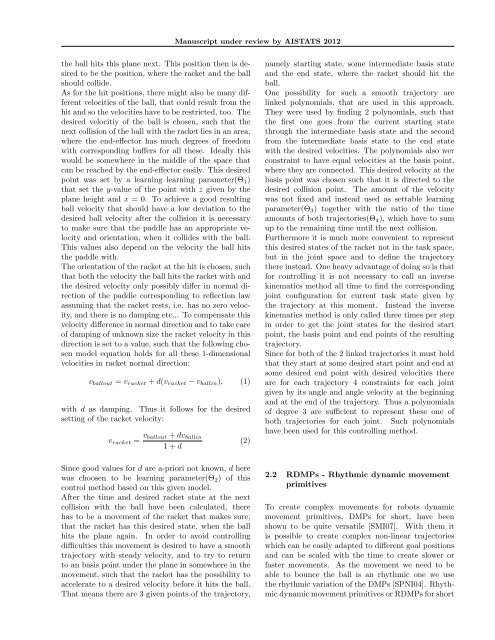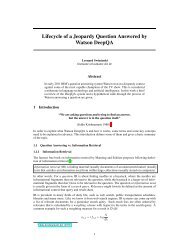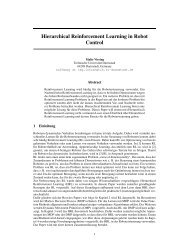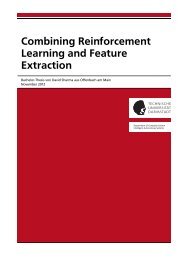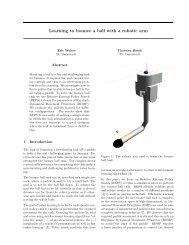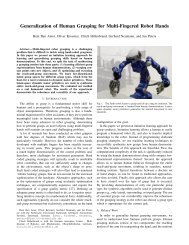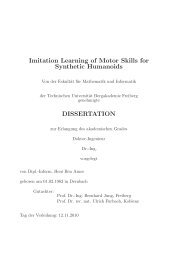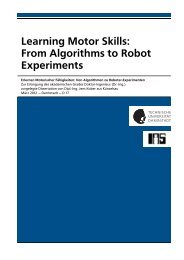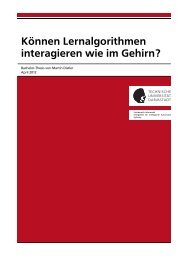Robot learning for ball bouncing
Robot learning for ball bouncing
Robot learning for ball bouncing
Create successful ePaper yourself
Turn your PDF publications into a flip-book with our unique Google optimized e-Paper software.
Manuscript under review by AISTATS 2012<br />
the <strong>ball</strong> hits this plane next. This position then is desired<br />
to be the position, where the racket and the <strong>ball</strong><br />
should collide.<br />
As <strong>for</strong> the hit positions, there might also be many different<br />
velocities of the <strong>ball</strong>, that could result from the<br />
hit and so the velocities have to be restricted, too. The<br />
desired velocitiy of the <strong>ball</strong> is chosen, such that the<br />
next collision of the <strong>ball</strong> with the racket lies in an area,<br />
where the end-effector has much degrees of freedom<br />
with corresponding buffers <strong>for</strong> all these. Ideally this<br />
would be somewhere in the middle of the space that<br />
can be reached by the end-effector easily. This desired<br />
point was set by a <strong>learning</strong> <strong>learning</strong> parameter(Θ 1 )<br />
that set the y-value of the point with z given by the<br />
plane height and x = 0. To achieve a good resulting<br />
<strong>ball</strong> velocity that should have a low deviation to the<br />
desired <strong>ball</strong> velocity after the collision it is necessary<br />
to make sure that the paddle has an appropriate velocity<br />
and orientation, when it collides with the <strong>ball</strong>.<br />
This values also depend on the velocity the <strong>ball</strong> hits<br />
the paddle with.<br />
The orientation of the racket at the hit is chosen, such<br />
that both the velocity the <strong>ball</strong> hits the racket with and<br />
the desired velocity only possibly differ in normal direction<br />
of the paddle corresponding to reflection law<br />
assuming that the racket rests, i.e. has no zero velocity,<br />
and there is no damping etc... To compensate this<br />
velocity difference in normal direction and to take care<br />
of damping of unknown size the racket velocity in this<br />
direction is set to a value, such that the following chosen<br />
model equation holds <strong>for</strong> all these 1-dimensional<br />
velocities in racket normal direction:<br />
v <strong>ball</strong>out = v racket + d(v racket − v <strong>ball</strong>in ), (1)<br />
with d as damping. Thus it follows <strong>for</strong> the desired<br />
setting of the racket velocity:<br />
v racket = v <strong>ball</strong>out + dv <strong>ball</strong>in<br />
1 + d<br />
(2)<br />
Since good values <strong>for</strong> d are a-priori not known, d here<br />
was choosen to be <strong>learning</strong> parameter(Θ 2 ) of this<br />
control method based on this given model.<br />
After the time and desired racket state at the next<br />
collision with the <strong>ball</strong> have been calculated, there<br />
has to be a movement of the racket that makes sure,<br />
that the racket has this desired state, when the <strong>ball</strong><br />
hits the plane again. In order to avoid controlling<br />
difficulties this movement is desired to have a smooth<br />
trajectory with steady velocity, and to try to return<br />
to an basis point under the plane in somewhere in the<br />
movement, such that the racket has the possibility to<br />
accelerate to a desired velocity be<strong>for</strong>e it hits the <strong>ball</strong>.<br />
That means there are 3 given points of the trajectory,<br />
namely starting state, some intermediate basis state<br />
and the end state, where the racket should hit the<br />
<strong>ball</strong>.<br />
One possibility <strong>for</strong> such a smooth trajectory are<br />
linked polynomials, that are used in this approach.<br />
They were used by finding 2 polynomials, such that<br />
the first one goes from the current starting state<br />
through the intermediate basis state and the second<br />
from the intermediate basis state to the end state<br />
with the desired velocities. The polynomials also wer<br />
constraint to have equal velocities at the basis point,<br />
where they are connected. This desired velocity at the<br />
basis point was chosen such that it is directed to the<br />
desired collision point. The amount of the velocity<br />
was not fixed and instead used as settable <strong>learning</strong><br />
parameter(Θ 3 ) together with the ratio of the time<br />
amounts of both trajectories(Θ 4 ), which have to sum<br />
up to the remaining time until the next collision.<br />
Furthermore it is much more convenient to represent<br />
this desired states of the racket not in the task space,<br />
but in the joint space and to define the trajectory<br />
there instead. One heavy advantage of doing so is that<br />
<strong>for</strong> controlling it is not necessary to call an inverse<br />
kinematics method all time to find the corresponding<br />
joint configuration <strong>for</strong> current task state given by<br />
the trajectory at this moment. Instead the inverse<br />
kinematics method is only called three times per step<br />
in order to get the joint states <strong>for</strong> the desired start<br />
point, the basis point and end points of the resulting<br />
trajectory.<br />
Since <strong>for</strong> both of the 2 linked trajectories it must hold<br />
that they start at some desired start point and end at<br />
some desired end point with desired velocities there<br />
are <strong>for</strong> each trajectory 4 constraints <strong>for</strong> each joint<br />
given by its angle and angle velocity at the beginning<br />
and at the end of the trajectory. Thus a polynomiala<br />
of degree 3 are sufficient to represent these one of<br />
both trajectories <strong>for</strong> each joint. Such polynomials<br />
have been used <strong>for</strong> this controlling method.<br />
2.2 RDMPs - Rhythmic dynamic movement<br />
primitives<br />
To create complex movements <strong>for</strong> robots dynamic<br />
movement primitives, DMPs <strong>for</strong> short, have been<br />
shown to be quite versatile [SMI07]. With them it<br />
is possible to create complex non-linear trajectories<br />
which can be easily adapted to different goal positions<br />
and can be scaled with the time to create slower or<br />
faster movements. As the movement we need to be<br />
able to bounce the <strong>ball</strong> is an rhythmic one we use<br />
the rhythmic variation of the DMPs [SPNI04]. Rhythmic<br />
dynamic movement primitives or RDMPs <strong>for</strong> short


